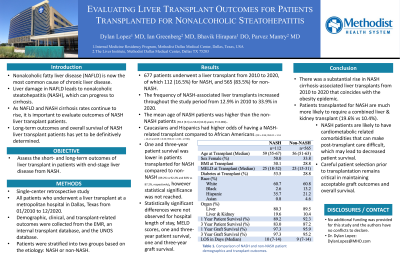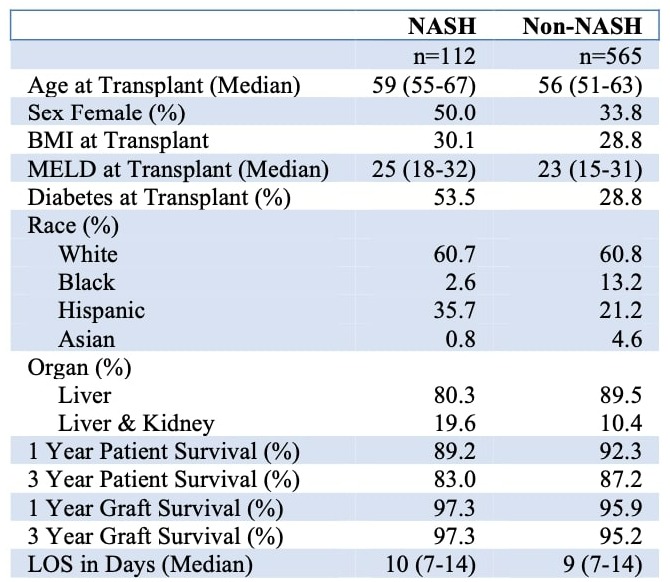Back


Poster Session D - Tuesday Morning
Category: Liver
D0508 - Evaluating Liver Transplant Outcomes for Patients Transplanted for Nonalcoholic Steatohepatitis
Tuesday, October 25, 2022
10:00 AM – 12:00 PM ET
Location: Crown Ballroom

Has Audio
- DL
Dylan Lopez, MD
Methodist Dallas Medical Center
Dallas, TX
Presenting Author(s)
Dylan Lopez, MD, Ian M. Greenberg, MD, Bhavik Hirapara, DO, Parvez Mantry, MD
Methodist Dallas Medical Center, Dallas, TX
Introduction: Nonalcoholic fatty liver disease (NAFLD) is now the most common cause of chronic liver disease. Liver damage in NAFLD leads to nonalcoholic steatohepatitis (NASH), which can progress to cirrhosis. As NASH cirrhosis rates continue to rise, it is important to evaluate outcomes of NASH liver transplant (LT) patients. Long-term outcomes and overall survival of NASH LT patients have yet to be definitively determined. The aim of this study was to assess LT outcomes in NASH patients.
Methods: This single-center retrospective analysis included all adult patients who underwent a LT at a large hospital in Dallas, TX from 2010 to 2020. Demographic, clinical, and transplant-related outcomes were collected. Patients were stratified into two groups based on the etiology of their underlying liver disease: NASH or non-NASH. Groups were compared using the Mann-Whitney U, Chi square, or the Fisher’s exact test.
Results: A total of 677 patients, 112 (16.5%) NASH and 565 (83.5%) non-NASH, underwent a LT from 2010 to 2020. The mean age of NASH patients was higher than the non-NASH patients (59.3 vs 56.0 years). Caucasians (OR=4.9; 95% CI=1.5–16.1; p=0.008) and Hispanics (OR=8.3; 95% CI=2.4–27.9; p=0.001) had higher odds of having a NASH-related LT compared to African Americans. A greater proportion of NASH patients were obese and had diabetes compared to non-NASH patients (47% vs 34%; respectively). The frequency of NASH-associated LT increased throughout the study period from 12.9% in 2010 to 33.9% in 2020. Mean hospital length of stay (p=0.18), Model for End-Stage Liver Disease scores (p=0.06), one-year survival (p=0.27), three-year survival (p=0.23), one-year graft survival (p=0.60), and three-year graft survival (p=0.45) were comparable between the two groups.
Discussion: Our 10-year cohort study showed a substantial rise in NASH cirrhosis-associated LT from 2010 to 2020 that coincides with the obesity epidemic. NASH patients are likely to have metabolic-related comorbidities such as obesity, diabetes, and coronary artery disease that can make post-transplant care difficult as they are prone to infections, poor healing, and death. Although not statistically significant, our data suggest that both one year and three-year patient survival was lower in NASH patients. Careful patient selection prior to transplantation remains critical in maintaining acceptable graft outcomes and overall survival.

Disclosures:
Dylan Lopez, MD, Ian M. Greenberg, MD, Bhavik Hirapara, DO, Parvez Mantry, MD. D0508 - Evaluating Liver Transplant Outcomes for Patients Transplanted for Nonalcoholic Steatohepatitis, ACG 2022 Annual Scientific Meeting Abstracts. Charlotte, NC: American College of Gastroenterology.
Methodist Dallas Medical Center, Dallas, TX
Introduction: Nonalcoholic fatty liver disease (NAFLD) is now the most common cause of chronic liver disease. Liver damage in NAFLD leads to nonalcoholic steatohepatitis (NASH), which can progress to cirrhosis. As NASH cirrhosis rates continue to rise, it is important to evaluate outcomes of NASH liver transplant (LT) patients. Long-term outcomes and overall survival of NASH LT patients have yet to be definitively determined. The aim of this study was to assess LT outcomes in NASH patients.
Methods: This single-center retrospective analysis included all adult patients who underwent a LT at a large hospital in Dallas, TX from 2010 to 2020. Demographic, clinical, and transplant-related outcomes were collected. Patients were stratified into two groups based on the etiology of their underlying liver disease: NASH or non-NASH. Groups were compared using the Mann-Whitney U, Chi square, or the Fisher’s exact test.
Results: A total of 677 patients, 112 (16.5%) NASH and 565 (83.5%) non-NASH, underwent a LT from 2010 to 2020. The mean age of NASH patients was higher than the non-NASH patients (59.3 vs 56.0 years). Caucasians (OR=4.9; 95% CI=1.5–16.1; p=0.008) and Hispanics (OR=8.3; 95% CI=2.4–27.9; p=0.001) had higher odds of having a NASH-related LT compared to African Americans. A greater proportion of NASH patients were obese and had diabetes compared to non-NASH patients (47% vs 34%; respectively). The frequency of NASH-associated LT increased throughout the study period from 12.9% in 2010 to 33.9% in 2020. Mean hospital length of stay (p=0.18), Model for End-Stage Liver Disease scores (p=0.06), one-year survival (p=0.27), three-year survival (p=0.23), one-year graft survival (p=0.60), and three-year graft survival (p=0.45) were comparable between the two groups.
Discussion: Our 10-year cohort study showed a substantial rise in NASH cirrhosis-associated LT from 2010 to 2020 that coincides with the obesity epidemic. NASH patients are likely to have metabolic-related comorbidities such as obesity, diabetes, and coronary artery disease that can make post-transplant care difficult as they are prone to infections, poor healing, and death. Although not statistically significant, our data suggest that both one year and three-year patient survival was lower in NASH patients. Careful patient selection prior to transplantation remains critical in maintaining acceptable graft outcomes and overall survival.

Figure: Table 1. Comparison of NASH and non-NASH patient demographics and outcomes.
Disclosures:
Dylan Lopez indicated no relevant financial relationships.
Ian Greenberg indicated no relevant financial relationships.
Bhavik Hirapara indicated no relevant financial relationships.
Parvez Mantry indicated no relevant financial relationships.
Dylan Lopez, MD, Ian M. Greenberg, MD, Bhavik Hirapara, DO, Parvez Mantry, MD. D0508 - Evaluating Liver Transplant Outcomes for Patients Transplanted for Nonalcoholic Steatohepatitis, ACG 2022 Annual Scientific Meeting Abstracts. Charlotte, NC: American College of Gastroenterology.
